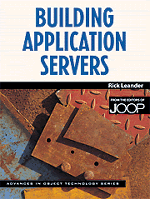Book contents
- Frontmatter
- Contents
- acknowledgements
- Introduction
- PART 1 ARCHITECTURE
- PART 2 DESIGN
- PART 3 PROGRAMMING
- Chapter 8 Implementing an Application Server Framework
- Chapter 9 Using Java to Build Business Objects
- Chapter 10 Persistent Objects: Communicating with Databases
- Chapter 11 Interfaces and Client-Side Communication
- Chapter 12 Enforcing Business Rules
- Chapter 13 Multiprocessing, Concurrency, and Transactions
- Chapter 14 The Next Generation of Business Applications
- Appendix: Setting up a Development Environment
- Index
Chapter 8 - Implementing an Application Server Framework
from PART 3 - PROGRAMMING
Published online by Cambridge University Press: 06 July 2010
- Frontmatter
- Contents
- acknowledgements
- Introduction
- PART 1 ARCHITECTURE
- PART 2 DESIGN
- PART 3 PROGRAMMING
- Chapter 8 Implementing an Application Server Framework
- Chapter 9 Using Java to Build Business Objects
- Chapter 10 Persistent Objects: Communicating with Databases
- Chapter 11 Interfaces and Client-Side Communication
- Chapter 12 Enforcing Business Rules
- Chapter 13 Multiprocessing, Concurrency, and Transactions
- Chapter 14 The Next Generation of Business Applications
- Appendix: Setting up a Development Environment
- Index
Summary
Up to now, this book has looked at application servers as abstract concepts—first from an architectural view, then from the designer's vantage point. It's almost time to roll up our sleeves and start the real work: translating the abstractions into program code. But before we can start programming, we need to establish a general framework that can hold the service interfaces, business objects, and persistent objects that implement the server. This chapter bridges the discussion between design and programming, describing how to establish this framework.
In addition to the program framework, we must also create an organizational framework that manages and structures the development process. This includes communication channels, programming tools, testing strategies and other administrative details. Although the emphasis of this book is on the technical side of application server development, these topics will also be discussed in this chapter.
This chapter will examine the following topics:
The application server framework
Additional application server requirements
Development strategies
The Application Server Framework
In the previous chapters, we examined each of the different application server layers as separate entities, each having different responsibilities and requirements. This is the advantage of using a layered architecture: each layer can be examined on its own, viewed independently. Business object design can focus on the needs of the application. Service interface design can implement services for the user interface. The persistence layer design can focus on mapping business objects to their representation inside databases or persistent storage. By focusing on a single layer at a time, it is easier to manage the complex requirements of the application server design.
- Type
- Chapter
- Information
- Building Application Servers , pp. 177 - 196Publisher: Cambridge University PressPrint publication year: 2000



